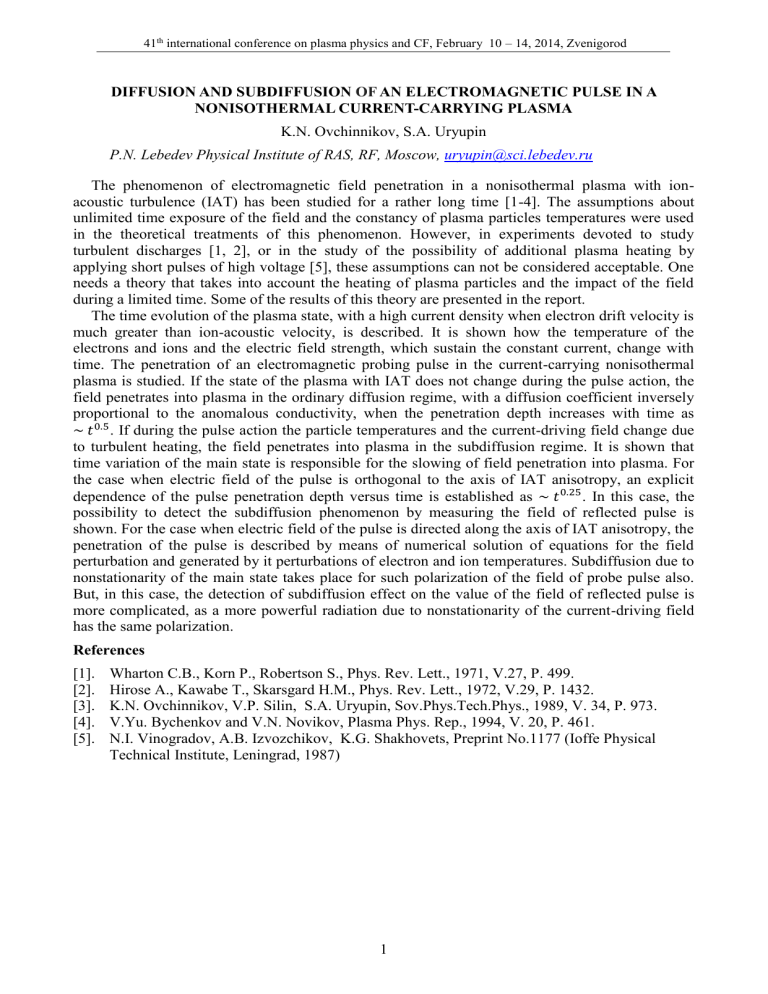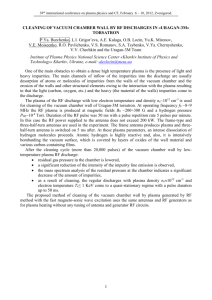Diffusion and subdiffusion OF an electromagnetic pulse in a

41 th international conference on plasma physics and CF, February 10 – 14, 2014, Zvenigorod
DIFFUSION AND SUBDIFFUSION OF AN ELECTROMAGNETIC PULSE IN A
NONISOTHERMAL CURRENT-CARRYING PLASMA
K.N. Ovchinnikov, S.А. Uryupin
P.N. Lebedev Physical Institute of RAS, RF, Moscow, uryupin@sci.lebedev.ru
The phenomenon of electromagnetic field penetration in a nonisothermal plasma with ionacoustic turbulence (IAT) has been studied for a rather long time [1-4]. The assumptions about unlimited time exposure of the field and the constancy of plasma particles temperatures were used in the theoretical treatments of this phenomenon. However, in experiments devoted to study turbulent discharges [1, 2], or in the study of the possibility of additional plasma heating by applying short pulses of high voltage [5], these assumptions can not be considered acceptable. One needs a theory that takes into account the heating of plasma particles and the impact of the field during a limited time. Some of the results of this theory are presented in the report.
The time evolution of the plasma state, with a high current density when electron drift velocity is much greater than ion-acoustic velocity, is described. It is shown how the temperature of the electrons and ions and the electric field strength, which sustain the constant current, change with time. The penetration of an electromagnetic probing pulse in the current-carrying nonisothermal plasma is studied. If the state of the plasma with IAT does not change during the pulse action, the field penetrates into plasma in the ordinary diffusion regime, with a diffusion coefficient inversely proportional to the anomalous conductivity, when the penetration depth increases with time as
~ 𝑡 0.5
. If during the pulse action the particle temperatures and the current-driving field change due to turbulent heating, the field penetrates into plasma in the subdiffusion regime. It is shown that time variation of the main state is responsible for the slowing of field penetration into plasma. For the case when electric field of the pulse is orthogonal to the axis of IAT anisotropy, an explicit dependence of the pulse penetration depth versus time is established as ~ 𝑡 0.25
. In this case, the possibility to detect the subdiffusion phenomenon by measuring the field of reflected pulse is shown. For the case when electric field of the pulse is directed along the axis of IAT anisotropy, the penetration of the pulse is described by means of numerical solution of equations for the field perturbation and generated by it perturbations of electron and ion temperatures. Subdiffusion due to nonstationarity of the main state takes place for such polarization of the field of probe pulse also.
But, in this case, the detection of subdiffusion effect on the value of the field of reflected pulse is more complicated, as a more powerful radiation due to nonstationarity of the current-driving field has the same polarization.
References
[1].
Wharton C.B., Korn P., Robertson S., Phys. Rev. Lett., 1971, V.27, P. 499.
[2].
Hirose A., Kawabe T., Skarsgard H.M., Phys. Rev. Lett., 1972, V.29, P. 1432.
[3].
K.N. Ovchinnikov, V.P. Silin, S.A. Uryupin, Sov.Phys.Tech.Phys., 1989, V. 34, P. 973.
[4].
V.Yu. Bychenkov and V.N. Novikov, Plasma Phys. Rep., 1994, V. 20, P. 461.
[5].
N.I. Vinogradov, A.B. Izvozchikov, K.G. Shakhovets, Preprint No.1177 (Ioffe Physical
Technical Institute, Leningrad, 1987)
1





